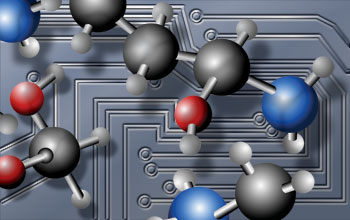News Release 05-191
Chemistry Meets Computer, Data and Networking Technologies
NSF announces first cyber-enabled chemistry awards

Chemistry meets computer, data and networking technologies in cyber-enabled chemistry awards.
November 1, 2005
This material is available primarily for archival purposes. Telephone numbers or other contact information may be out of date; please see current contact information at media contacts.
The National Science Foundation (NSF) has announced the first round of grants in "cyber-enabled chemistry," a program developed by its chemistry division to explore how researchers and educators in that field can fully exploit the potential of cyberinfrastructure.
The lead principal investigators for the four awards include two researchers in separate projects at the University of California, Berkeley, and one each at the University of Illinois at Urbana-Champaign and The Pennsylvania State University. The awards represent a combined investment of about $10 million over a 5-year period, including co-funding from NSF's former Division of Shared Cyberinfrastructure.
"Cyberinfrastructure" is an umbrella term meant to encompass the vast webs of computer, data and networking technologies that have infiltrated every aspect of modern life, and that are now beginning to revolutionize science and engineering research.
The goal of the cyber-enabled chemistry program--formally known as Chemistry Research Instrumentation and Facilities: Cyberinfrastructure and Research Facilities--is to ensure that chemists can take full advantage of that revolution. In particular, the program seeks to
- foster new chemical research and education activities through the use of grid computing, community databases, remote access to instrumentation, electronic support for geographically-dispersed collaborations, and other web- and grid-accessible services
- help teams of researchers assemble distributed expertise and resources into integrated virtual laboratories
- impact the day-to-day practice of chemistry though advances such as scientific portals, workflow management, computational modeling, and data and molecular visualization
- access the expertise and resources that cyberinfrastructure provides to greatly broaden participation in the chemical sciences, and to create a truly inclusive national and international community
-NSF-
Chemistry Research Instrumentation and Facilities: Cyberinfrastructure and Research Facilities Awards for 2005
-
Cyberinfrastructure for Next-Generation Biomolecular Modeling
Lead PI: Teresa Head-Gordon, University of California, Berkeley,
TLHead-Gordon@lbl.gov
The participants in this project include Teresa Head-Gordon and Martin Head-Gordon of the University of California at Berkeley, Vijay Pande of Stanford University, and Jay Ponder of Washington University. They will seek to develop and validate new ways of simulating biological molecules. They will publicly distribute the resulting software. And they will offer workshops to teach these tools to the research community at large.
- Tools for Ab Initio Molecular Dynamics and Simulation Analysis
Lead PI: Todd J. Martínez, University of Illinois at Urbana-Champaign, tjm@spawn.scs.uiuc.edu
The participants in this project include Todd Martinez of the University of Illinois, and Mark Gordon, Brett Bode, Ricky Kendall, and Masha Sosonkina of Iowa State University. Their goal is to combine state-of-the-art molecular simulation techniques in a publicly available computer code, for use by both experts and non-experts. Outcomes of this project include publicly available software tools, along with a workshop for dissemination.
- Developing Collaboratory Tools to Facilitate Multi-Disciplinary, Multi-Scale Research in Environmental Molecular Sciences
Lead PI: Karl Mueller, The Pennsylvania State University, ktm2@psu.edu
The participants in this project include Karl Mueller, Barbara Garrison, C. L. Giles, and Prasenjit Mitra of Pennsylvania State University. They plan to take a multidisciplinary approach to integrating information about environmental chemistry across many different scales of space and time. A database will be developed at the Center for Environmental Kinetics Analysis, an NSF-supported Environmental Molecular Science Institute, to improve communication among scientists working in various disciplines and at vastly different scales. In this project, a team of chemists and experts in information technology will create an easily queried, intelligent database designed for ready access and use; automate the uploading and collection of data; design and build a search engine and digital library for active data and information acquisition; create an interface for conducting experiments; and develop an intelligent user interface.
- Process Informatics for Chemical Reaction Systems
Lead PI: Michael Frenklach, University of California, Berkeley, myf@me.berkeley.edu
The participants in this project include Michael Frenklach and Andrew Packard of the University of California at Berkeley, Craig Bowman of Stanford University, and William Green and Gregory McRae of the Massachusetts Institute of Technology. They propose to develop tools and cyberinfrastructure to curate a variety of chemical data. These tools will include file management, database mining, and data visualization, as well as tools to assess and assure the consistency of the data. The principal goal of this award is a proof-of-concept demonstration that collaborative data analysis and decision making will create qualitatively new advances in chemical sciences.
Media Contacts
M. Mitchell Waldrop, NSF, (703) 292-7752, email: mwaldrop@nsf.gov
Program Contacts
Celeste Rohlfing, NSF, (703) 292-4962, email: crohlfin@nsf.gov
The U.S. National Science Foundation propels the nation forward by advancing fundamental research in all fields of science and engineering. NSF supports research and people by providing facilities, instruments and funding to support their ingenuity and sustain the U.S. as a global leader in research and innovation. With a fiscal year 2023 budget of $9.5 billion, NSF funds reach all 50 states through grants to nearly 2,000 colleges, universities and institutions. Each year, NSF receives more than 40,000 competitive proposals and makes about 11,000 new awards. Those awards include support for cooperative research with industry, Arctic and Antarctic research and operations, and U.S. participation in international scientific efforts.
Connect with us online
NSF website: nsf.gov
NSF News: nsf.gov/news
For News Media: nsf.gov/news/newsroom
Statistics: nsf.gov/statistics/
Awards database: nsf.gov/awardsearch/
Follow us on social
Twitter: twitter.com/NSF
Facebook: facebook.com/US.NSF
Instagram: instagram.com/nsfgov
